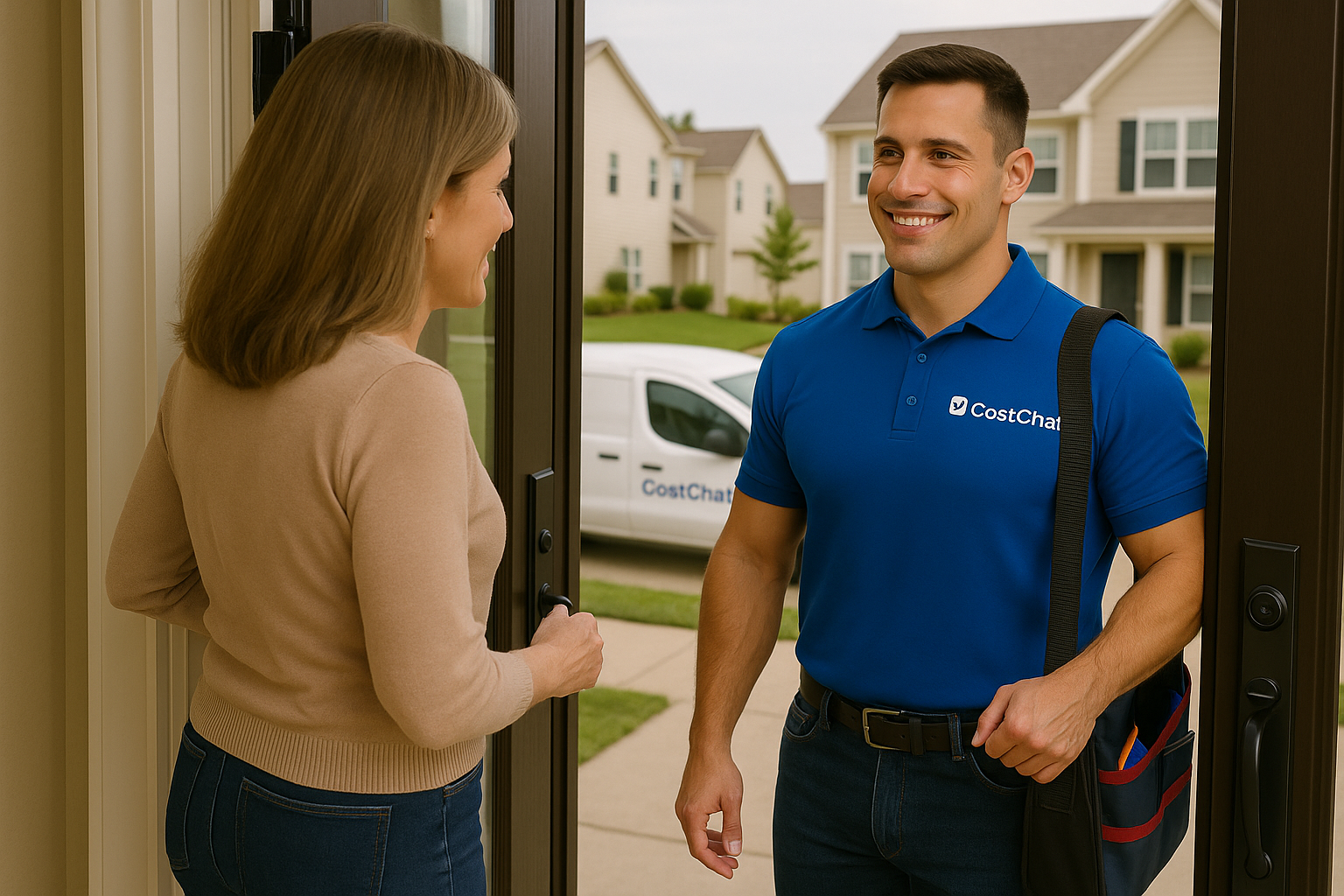
Find Top Local Sewer Line Repair Providers in Springfield, MA – Book Today
How to Hire Top Rated Sewer Line Repair Pros in Springfield, MA
Get a Free Online Estimate
Share your project details and receive a free online estimate from top-rated local pros. Not sure what it should cost? Check our Cost Guide.
Get EstimateCompare Local Quotes
View multiple free online quotes side by side. Use our Price Guide to understand labor rates, materials, and service fees before you hire.
Compare NowBook Best Top Rated Pros
Choose a licensed pro with confidence. Lock in your date after reviewing your free estimate and browsing our expert Cost Guide for peace of mind.
Book NowDid You Know?
74% ⚠️
of homeowners face surprise costs and delays — mostly from hiring unvetted pros. Don’t risk it. Hire trusted experts today.
Hire Top Rated & Verified ProsWork With Verified & Trusted Pros 🛡️
Save time, avoid costly mistakes, and experience reliable, top-quality service for every home project. Book now for priority scheduling and peace of mind.
Hire a Top Rated ProGet Instant Online Estimate of Sewer Line Repair in
🔎 CostChat Online Cost Estimator
Describe your project and location to get an instant estimate.
Your Comprehensive Guide to Sewer Line Repair in Springfield, MA
Living in Springfield, MA, means cherishing our city’s unique character and historic charm. For many homeowners, this includes beautiful older homes that tell a story. However, as stewards of these properties, we also understand the unique challenges that come with maintaining them, especially when it involves the hidden, yet crucial, infrastructure like sewer lines. When you suspect a problem, from slow drains to unpleasant odors, facing sewer line issues can feel daunting. This guide is crafted specifically for you, the Springfield homeowner, to provide clear, actionable information on understanding, identifying, and resolving sewer line problems, ensuring your home remains comfortable and healthy.
We’ll navigate the specifics of Springfield's housing stock, its climate impact, local regulations, and what to expect when choosing a professional. Our goal is to empower you with the knowledge needed to make informed decisions about your home’s sewer line health.
Table of Contents
- Springfield, MA's Unique Sewer Line Repair Landscape: Why Local Expertise Matters
- Neighborhood Hotspots: Micro-Local Sewer Line Repair Risks & Solutions
- Common Problems & Triggers for a Professional Sewer Line Repair Call
- Navigating Springfield, MA Regulations: Permits, Code & Professional Licensing
- Maximize Your Savings: Sewer Line Repair Rebates & Incentives in Springfield, MA
- Choosing Your Springfield, MA Sewer Line Repair: Models, Sizing & Smart Features
- Cost of Sewer Line Repair in Springfield, MA
- Hiring Springfield, MA's Top-Rated Sewer Line Repair Professional: Your Action Plan
- FAQs About Sewer Line Repair in Springfield, MA
Springfield, MA's Unique Sewer Line Repair Landscape: Why Local Expertise Matters
1.1 The Age & Character of Springfield, MA Homes: A Sewer Line Repair-Related Time Capsule
Springfield, MA, with its estimated population of about 153,000 residents spread over 33 square miles, boasts a rich architectural tapestry, much of which presents unique challenges for sewer line infrastructure. A significant portion of our housing stock, with many homes built before 1950, means older materials and systems are common.
- Pre-1950 Homes: These homes, often found in historic neighborhoods like Forest Park, frequently feature original plumbing, including cast iron or even clay sewer lines. These materials are prone to corrosion, root intrusion, and cracking due to age and soil pressure. Architectural styles common in this era include Colonial and Victorian, which may have complex layouts, making access for repairs more challenging.
- Mid-Century Homes (1950s-1970s): You'll find many homes from this period in areas like the South End. While some may have had updates, others could still have early forms of PVC or older metal pipes, which, while better than cast iron, can still degrade, particularly with ground shifts or improper installation techniques of the time.
The prevalence of owner-occupied homes, around 50-60%, indicates a strong community investment in property maintenance. However, the age of the infrastructure is a significant factor in the longevity and reliability of sewer lines.
1.2 Springfield, MA's Environmental & Utility Factors & Climate Impact on Your Sewer Line Repair
Understanding Springfield’s environment is key to understanding sewer line performance and potential issues. The Springfield Water and Sewer Commission supplies our water, primarily sourced from reservoirs in Blandford and Granville. While treated to be safe, the natural mineral content contributes to moderately hard water, which over decades, can lead to scale buildup within pipes, potentially narrowing them and exacerbating blockages.
Springfield experiences a humid continental climate with distinct seasons. This means:
- Cold Winters: Frequent freeze-thaw cycles from late fall through early spring can impact underground pipes. Soil expansion and contraction due to freezing and thawing can stress pipe joints, leading to cracks and leaks, especially in areas with poor soil stability or exposed plumbing.
- Seasonal Rainfall: Springfield experiences periods of heavy rainfall. Older neighborhoods may have less robust stormwater management systems, increasing the risk of groundwater infiltration into compromised sewer lines, leading to backups and potential basement flooding.
These environmental and climatic factors can significantly influence the lifespan and operational efficiency of your sewer line system, making proactive maintenance and timely repairs crucial.
 Request a Quote Today
Request a Quote TodayNeighborhood Hotspots: Micro-Local Sewer Line Repair Risks & Solutions
Springfield's diverse neighborhoods each present their own unique set of challenges when it comes to sewer lines:
- Forest Park Area: Known for its beautiful, often older homes, this neighborhood commonly faces issues related to aging cast iron pipes and extensive tree root intrusion due to mature landscaping. Solutions here often involve pipe lining (trenchless repair) to avoid disturbing historic properties or full replacements for severely deteriorated sections.
- South End: This area features a mix of housing stock, including many homes built post-WWII. While perhaps less prone to the oldest pipe materials, settlement issues and potential connections to aging municipal lines can cause problems. Careful inspection and understanding of the specific connection points are vital.
- Indian Orchard: With a history of industrial activity and a mix of older residential structures, properties in Indian Orchard may contend with corroded pipes and potential impact from historical soil conditions. Thorough camera inspections are recommended to assess the exact nature of any pipe degradation.
- Sixteen Acres: This neighborhood, with a blend of housing styles, can experience issues related to hydrostatic pressure and potential drainage problems, especially during heavy rain events, due to its topography and older underground infrastructure. Ensuring proper grading and sump pump functionality can complement sewer line integrity.
Common Problems & Triggers for a Professional Sewer Line Repair Call
Recognizing the signs of a failing sewer line is the first step to preventing more significant damage. For Springfield homeowners, these can be particularly indicative:
- Slow Drains or Multiple Clogged Fixtures: A common indicator that your main sewer line may be partially blocked. This is more likely in older homes with pipe corrosion or root infiltration.
- Gurgling Sounds: Strange noises from toilets or drains often signify trapped air, a sign of a blockage preventing proper flow.
- Foul Odors: The smell of sewage, especially around drains or in the basement, is a strong signal of a leak or break in the sewer line.
- Sewage Backups: This is a critical emergency. If sewage backs up into your toilets, sinks, or shower drains, it means the main line is completely obstructed.
- Visible Water Damage or Soggy Spots: Unexplained wet patches in your yard, particularly around the sewer line path, can indicate a leak.
The underlying causes often tie back to Springfield's housing age, with corrosion in older galvanized steel or cast iron pipes being a primary culprit. Tree root intrusion is also a frequent issue, as roots seek water and can easily infiltrate even small cracks in aging pipes. Over time, pipe sagging or bellies can form, creating low spots where debris collects and blockages are more likely.
For more detailed information on spotting these issues, consult our guide on Warning Signs You Need Sewer Line Repair. If you encounter a sudden, severe sewer backup, learn What to Do in a Plumbing Emergency.
 Get Expert Help Now
Get Expert Help NowNavigating Springfield, MA Regulations: Permits, Code & Professional Licensing
Ensuring your sewer line work is done correctly involves understanding local regulations. In Springfield, all significant plumbing work, including sewer line repairs or replacements, requires permits to ensure safety and adherence to code.
- Permitting Authority: Permits are issued by the City of Springfield’s Inspectional Services Department. You can find more information on their website: springfield-ma.gov/inspectionalservices.
- Governing Code: Springfield follows the Massachusetts State Plumbing Code, which is based on the Uniform State Plumbing Code (derived from the International Plumbing Code). This code includes state-specific amendments to address local conditions.
- Required Inspections: Typically, inspections are required at various stages of sewer line work, including after the trench is dug but before backfilling, and after the new lines are installed and connected. Your contractor will coordinate these with the city.
- DIY vs. Professional: While some minor plumbing tasks might be DIY-friendly, sewer line repair is a complex and often hazardous job that connects directly to the municipal sewer system. It requires specialized knowledge, tools, and adherence to strict codes to prevent health risks and environmental contamination. For this reason, professional installation is highly recommended. For guidance on when DIY might be an option for less critical tasks, see our When to Consider DIY guide.
- Contractor Licensing: All plumbing work in Massachusetts must be performed by a licensed plumber. The Massachusetts Board of State Examiners of Plumbers and Gas Fitters oversees licensing. You can verify a contractor’s license status through the state’s online portal: Mass.gov. Always ensure your chosen professional is licensed and insured.
Maximize Your Savings: Sewer Line Repair Rebates & Incentives in Springfield, MA
Springfield homeowners can potentially offset the cost of certain upgrades or repairs through various rebate programs. While direct rebates for sewer line repair itself are uncommon, efficiency upgrades that might be part of a larger plumbing overhaul can qualify.
- Mass Save: This statewide program offers rebates and incentives for energy-efficient upgrades, including high-efficiency water heaters and certain plumbing fixtures. Check their website for the latest offers: masssave.com.
- Water Conservation Programs: Local water utilities may offer rebates for installing low-flow fixtures or water-saving devices. While not directly for sewer lines, these can reduce overall water usage, lessening the load on your system.
Bonus Tip: Strategically time larger sewer line projects with other planned renovations. This can sometimes allow you to bundle services and potentially leverage existing temporary financing offers.
For more ways to save on home services, explore our Saving Tips guide.
 Get Your Free Quote
Get Your Free QuoteChoosing Your Springfield, MA Sewer Line Repair: Models, Sizing & Smart Features
When it comes to sewer line repair or replacement in Springfield, the primary consideration is the material and method used. Modern solutions offer superior durability compared to older systems.
- Trenchless Sewer Line Repair (Lining/Pipe Bursting):
- Pros: Minimally invasive, preserves landscaping, often faster than traditional digging, extends pipe life. Ideal for older Springfield homes where preserving historic properties is important.
- Cons: May not be suitable for severely collapsed pipes, can be more expensive upfront than traditional methods.
- Traditional Trenching and Replacement:
- Pros: Cost-effective for simpler repairs, allows for complete replacement of old pipe sections.
- Cons: Highly disruptive to landscaping and property, requires extensive excavation, longer project timelines.
Sizing/Application Guidance for Springfield Homes: Standard residential sewer line sizes typically range from 4 to 6 inches in diameter, depending on the number of fixtures and bathrooms in the home. A professional assessment will determine the correct size and type of pipe for your specific needs, ensuring compliance with the Massachusetts State Plumbing Code.
Key Springfield Sewer Line Considerations:
- Soil Conditions: Springfield’s varied soil types and potential for movement due to freeze-thaw cycles mean durable pipe materials and proper bedding are essential.
- Depth of Existing Lines: Older homes may have sewer lines laid at varying depths, affecting excavation complexity and cost.
- Proximity to Trees: If your property has mature trees, especially near the sewer line path, root intrusion is a significant concern, favoring trenchless solutions where possible.
Cost of Sewer Line Repair in Springfield, MA
The cost of sewer line repair in Springfield, MA, can vary significantly based on the scope of work, the method used, and the specific challenges encountered on your property. As a general guideline, for homes built before 1950, you might expect costs to be on the higher end due to the prevalence of older, more fragile materials and potential complexities.
- Minor Repairs (e.g., joint leaks, small cracks): $1,000 - $3,000. These might involve localized fixes or sealing.
- Trenchless Pipe Lining: $4,000 - $15,000+, depending on the length and diameter of the pipe needing relining. This method is less disruptive but can be more expensive initially than digging.
- Full Sewer Line Replacement (Trenching): $6,000 - $25,000+, depending on the distance from the house to the street connection, accessibility, and material used (e.g., PVC, cast iron). This is often the most costly option due to labor and excavation requirements.
Factors Influencing Costs:
- Pipe Material: Replacing brittle cast iron is often more complex than modern PVC.
- Extent of Damage: A full break will cost more than a minor leak.
- Accessibility: Difficult terrain or landscaping can increase labor costs.
- Permit Fees: Required by the City of Springfield.
- Depth of Excavation: Deeper lines mean more labor and material.
Considering the median household income in Springfield is approximately $51,339, homeowners should budget carefully. It is always recommended to obtain at least three detailed quotes from licensed professionals to compare pricing and scope of work.
Hiring Springfield, MA's Top-Rated Sewer Line Repair Professional: Your Action Plan
Choosing the right professional is critical for ensuring a lasting and compliant sewer line repair. Here’s your action plan:
- Verify Licensing and Insurance: Always ensure the plumber holds a valid Massachusetts license and carries general liability insurance. This protects you from faulty work and accidents. You can verify licenses via Mass.gov.
- Seek Local Experience: Professionals familiar with Springfield’s specific building codes, common soil conditions, and older infrastructure will be better equipped to handle your job.
- Hyper-Local Questions to Ask:
- "Have you performed sewer line repairs in the Forest Park neighborhood before?"
- "What are the most common sewer line issues you encounter in Springfield homes of similar age to mine?"
- "Can you explain the specific trenchless technologies you use and why they might be suitable for my property?"
- "What type of pipe material do you recommend for Springfield's climate and soil conditions, and why?"
- "What is your process for obtaining permits from the City of Springfield?"
- Get Multiple Detailed Quotes: Don't settle for the first estimate. Request written quotes that clearly outline the scope of work, materials used, labor costs, permit fees, and warranty information.
- Check Reviews and References: Look for online reviews and ask for references from previous clients in Springfield.
- Understand the Contract: Ensure you have a detailed written contract that covers all aspects of the project before work begins.
Avoid common pitfalls by reading our guide on Mistakes to Avoid When Hiring a Contractor.
Neighborhoods We Serve in Springfield, MA
️ Top Neighborhoods:
- Bay
- Boston Road
- Brightwood
- East Forest Park
- East Springfield
- Forest Park
- Indian Orchard
- Liberty Heights
- McKnight Historic District
- Memorial Square
- Metro Center
- Old Hill
- Pine Point
- Six Corners
- Sixteen Acres
- Upper Hill
Top ZIP Codes Covered:
- 01103
- 01104
- 01105
- 01107
- 01108
- 01109
- 01118
- 01119
- 01128
- 01129
- 01151
- 01089
- 01106
- 01199
Wherever you’re located in Springfield, MA, our team of trusted local pros is nearby—ready to deliver fast, reliable, and top-rated service. Whether you’re in the heart of downtown or a quiet suburb, we’ve got you covered.
FAQs About Sewer Line Repair in Springfield, MA
For Springfield homes, especially those built before 1950, the most common sewer line issues include corrosion of cast iron or galvanized steel pipes, tree root intrusion from mature landscaping, and the gradual effects of pipe sagging or cracking due to soil movement and age. The city's climate with freeze-thaw cycles can also exacerbate existing pipe weaknesses.
Springfield's water is moderately hard, meaning it contains natural minerals. Over long periods, these minerals can lead to scale buildup inside pipes. While this is more of a concern for water supply lines, severe buildup in sewer lines can contribute to blockages and reduce flow efficiency, especially in older pipes that already have rough interiors.
Yes, generally, any significant sewer line repair or replacement work in Springfield requires a permit from the City of Springfield’s Inspectional Services Department. This ensures the work meets state plumbing codes and is performed safely. Licensed professionals will handle the permitting process.
In Springfield, mature trees are common in many neighborhoods. Tree roots are naturally attracted to the water and nutrients within sewer pipes. Even tiny cracks or loose joints in older pipes can allow roots to enter. Once inside, roots grow and can significantly widen the crack, eventually leading to blockages or complete pipe collapse.
Traditional replacement involves digging a trench from your house to the city connection, removing the old pipe, and installing a new one. It's disruptive. Trenchless repair methods, like pipe lining or pipe bursting, are less invasive. They typically involve creating small access points and either lining the inside of the existing pipe or pulling a new pipe through the old one. This significantly reduces landscape damage and is often preferred in areas where preserving yards is a priority.
